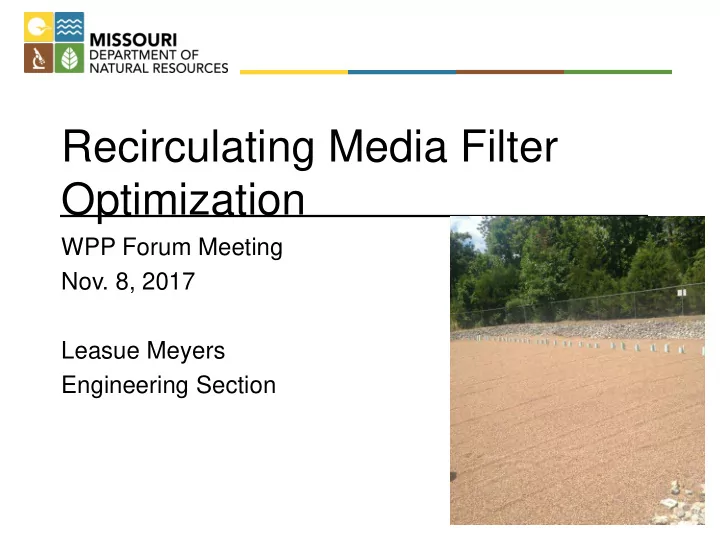

Recirculating Media Filter Optimization WPP Forum Meeting Nov. 8, 2017 Leasue Meyers Engineering Section 1
Objectives • Background on Recirculating Media Filters (RMFs) • Optimization Guide – http://dnr.mo.gov/env/wpp/cwforum/docs/110817- optimizing-filters-draft.pdf • Comments – leasue.meyers@dnr.mo.gov – Dec.15, 2017 2
Recirculating Media Filters (RMF) Pros Cons • Low cost • Limited to small facilities – Capital and O&M • Intermediate land • Low O&M requirement • Reliable and passive • Variable ammonia treatment effluent quality • High quality effluent • Temperature – ≈ 85% BOD removal susceptible – ≈ 95% TSS removal 3
RMF Distribution 600 500 521 400 Number of WWTFs 300 200 POTW Private 100 71 4 2 0 0 0 Small (< 0.1 MGD) Medium ( ≤ 0.1 & Large (≥ 0.5 MGD) < 0.5 MGD) 4
Ammonia Criteria – Driving Force • 110 RMFs with a Schedule of Compliance to meet ammonia effluent limits – Summer –3.6 mg/L daily max –1.4 mg/L monthly avg – Winter –7.5 mg/L daily max –2.9 mg/L monthly avg 5
RMF Alternatives • Mechanical plant • Regionalization • No-Discharge • Innovative technology – Moving Bed Biofilm Reactors (MBBRs) • Retrofits? 6
RMF Resources • Regional Office Water Specialists • UNDER DEVELOPMENT – Operations and Maintenance Manual – Optimization Guide 7
Operations and Maintenance Manual • Best practices to operate and maintain existing systems • Developed for owners and operators • Currently under development • Goal finalization and posting: Jan. 2018 »Contact: E.C. West »e.c.west@dnr.mo.gov 8
Optimization Alternatives Guide • Implementing Optimization • Operational Improvements • Primary Treatment • Equalization Tank • Screened Outlets • Recycle Line • Recirculation Tank • Chemical Dosing • Filter Bed • Underdrains 9
Implementing Optimization-Sampling • Sample multiple locations and during multiple operating conditions before optimizing • Characterizes the wastewater through the system – Impacts of Inflow and Infiltration – Identify the optimization alternatives that may improve performance Location Potential Parameters to monitor Influent Alkalinity, Ammonia, BOD, COD, DO, flow, pH, temperature, TN, total organic carbon (TOC), TSS Septic tank effluent Alkalinity, Ammonia, BOD, flow, pH, temperature, TN, TOC, TSS Recirculation Tank Alkalinity, Ammonia, BOD, COD, DO, flow, pH, temperature, TN, TOC, TSS Recycle Line Alkalinity, Ammonia, COD, DO, flow, pH, temperature, TN, TOC 10 Discharge effluent Alkalinity, Ammonia, BOD, flow, pH, TN, TSS
Operational Improvements • Proper Operation and Maintenance – Operations and Maintenance Manual – Call an Water Specialist in the Regional Office • Verify System Design and Construction – What was the hydraulic and organic design basis? – Are all design components installed and operational? 11
Primary Treatment • Septic Tank – Should provide 36 to 48 hours detention time at peak hourly flow • Equalization Tank – Recommended for compressed flows from schools, churches, etc… • Screened outlets – Additional removal of solids before entering the recirculation tank 12
Recycle Line • Traditionally water is returned to the Recirculation Tank • Returning water to the head of the septic tank has shown to increase nitrogen removal by 50% (EPA). • Optimal may be splitting the return water and returning part to the recirculation tank and part to the septic tank. 13
Floating media in Recirculation Tank • Pilot Project in 2016 • Floating media added to the recirculation tank • Ammonia concentrations dropped by 98% • Did experience more operations and maintenance cost 14
Recirculation Rates • Most RMFs have a recirculation ratio of 4:1, with 80% of the flow being returned and 20% discharged – Increasing the recirculation ratio to between 5:1 to 7:1 improves ammonia removal by minimizing dissolved oxygen and maximizing denitrification • May need larger recirculation tank or pump • Recirculation rates 8:1 or higher are not recommended – Alkalinity may be a concern at higher rates 15
Recirculation Tank-Chemical Dosing • Depending on wastewater’s characteristics, may need to add alkalinity or carbon to maximize treatment. – Alkalinity is the ability to neutralize acid. It takes 8 mg of alkalinity to remove 1 mg of ammonia – Carbon is necessary for denitrification to occur. 16
Common Chemicals for Dosing • Alkalinity for • Carbon for nitrification denitrification – Sodium hydroxide – Methanol – Calcium hydroxide – Glycerin – Calcium oxide – Acetic Acid – Sodium Carbonate – Sugar or Carbohydrate based compounds 17
Filter Bed • Good maintenance is key • Replace media with finer grain or synthetic media – Ideal media has high surface area to volume ratio, large enough voids to allow rapid air filtration and minimize fouling – Increasing filters beds or adding zones are options • Covers to help with temperature control and stormwater diversion 18
Underdrain • Verify there are cleanouts and they are not plugged • Pilot Project in 2016- blower added to the underdrain of the system, saw a 90% reduction in ammonia concentration. 19
Summary Table 20
RMF Optimization Guide • http://dnr.mo.gov/env/wpp/cwforum/docs/110817 -optimizing-filters-draft.pdf • Comments on the Optimization Guide or on additional optimization techniques, please send to Leasue Meyers – leasue.meyers@dnr.mo.gov • Comments due Dec. 15, 2017 • Goal finalization & posting: Jan. 2018 21
Questions 22
Water Specialists in Regional Offices • KCRO • SLRO – Leonard Johnson – Jeffrey Crannick – 816.622.7017 – 636.931.5200 – leonard.johnson@dnr.mo.gov – jeff.crannick@dnr.mo.gov • NERO • SWRO – Troy LaLond – E.C. West – 660.385.8062 – 417.891.4339 – troy.lalond@dnr.mo.gov – e.c.west@dnr.mo.gov • SERO – Frank Shovlin – 573.840.9023 – frank.shovlin@dnr.mo.gov 23
Recommend
More recommend